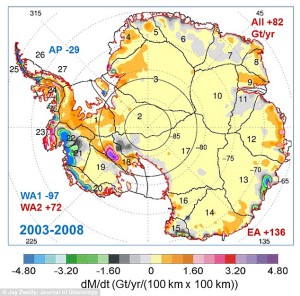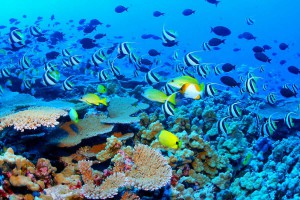Below you will find a beautiful timelapse of the Mojave Desert, shot and edited by astrophotographer Harun Mehmedinovic, that managed to capture a meteorite explosion.
MOJAVE BLUES from Harun Mehmedinovic on Vimeo.
The Research of Dr. Ivana De Domenico
Below you will find a beautiful timelapse of the Mojave Desert, shot and edited by astrophotographer Harun Mehmedinovic, that managed to capture a meteorite explosion.
MOJAVE BLUES from Harun Mehmedinovic on Vimeo.
Researchers, scientists, and engineers from around the world are continuing to push the limits of what is possible. What these people are discovering have the potential to improve our lives in incredible ways. I have compiled three different stories that are each promising in their own right.
Here are three research stories that you should be aware of today:
Bionic Spinal Cord
Researchers in Australia have created a “bionic spinal cord” that they claim would give paralyzed people significant hope of walking again. What makes the device even more amazing is that it could actually be utilized through the power of thought, without the need for open brain surgery.
The researchers proof-of-concept results come from a study conducted on sheep, demonstrating high fidelity measurements taken from the region of the brain responsible for controlling voluntary movement with the use of the device.
Vertically Launching Electric Plane
Elon Musk has been a technology pioneer. Helping to build companies such as PayPal, Tesla, and SpaceX. Each of these companies has revolutionized (or are in the process of revolutionizing) their respective industries. Now, Musk has his sights on building an electric-powered plane.
During a Q&A session for the Hyperloop Pod ceremony, Musk was asked to tell the audience what his next big idea was. Musk’s response: “Well I have been thinking about the vertical takeoff and landing electric jet a bit more. I mean, I think I have something that might close. I’m quite tempted to do something about it.”
Can Our Minds Live Forever?
Scientists are looking to preserve a brain, along with all of its thoughts, memories, feelings and everything else that makes us who we are, even after we have passed. To accomplish “life beyond life,” they are looking to preserve a brain’s connectome. While they are still unsure about whether this is possible, the scientists are developing techniques that they believe will answer this question.
Kenneth Hayworth, a neuroscientist and the brainchild behind the Brain Preservation Technology Prize, believes that this technology will be possible. During an interview with Scientific America, Hayworth stated that he is “virtually certain that mind uploading is possible. Our best neuroscience models say that all these perceptual and sensorimotor memories are stored as static changes in the synapses between neurons.” This is exactly what the technique is designed to preserve.
We are only a few short weeks into 2016 and we already have a number of amazing new research breakthroughs. These new discoveries will likely have major impacts in both the medical and technological industries. Here are three scientific research developments that you should know about.
1) Cornell scientists confirm atoms will not move when someone is observing them
Cornell physicists proved that a quantum system cannot change while you are watching it. This effect was considered to be one of the oddest predictions of quantum theory, and the recent experiments confirmed it.
Mukund Vegalettore, assistant professor of physics, established Cornell’s first program to study the physics of materials cooled to temperatures as low as .000000001 above absolute zero. For the experiment, a group of graduate students created and cooled a gas of about a billion Rubidium atoms inside a vacuum chamber and suspended the mass between laser beams. It was during this experiment that the team noticed the atoms would not move around as long as they were under observation. The more often the group used a laser to measure the behavior, the less movement they were able to see.
This study has some fairly big ramifications, such as showing that quantum cryptography should actually work, meaning that an intruder can’t spy on your communications without destroying the data.
2) Scientists teach bacteria to perform artificial photosynthesis
Scientists have successfully induced Moorella thermoacetica, an originally nonphotosynthetic bacterium, to undergo photosynthesis in a hybrid artificial photosynthesis system for converting sunlight. The M. thermoacetica was coaxed to perform photosynthesis, even though it is naturally non-photosynthetic; the scientists essentially trained the bacteria to perform something that it was naturally genetically programmed to not do.
“We’ve demonstrated the first self-photosensitization of a nonphotosynthetic bacterium, M. thermoacetica, with cadmium sulfide nanoparticles to produce acetic acid from carbon dioxide at efficiencies and yield that are comparable to or may even exceed the capabilities of natural photosynthesis,” stated Peidong Yang, a chemist with Berkeley Lab’s Materials Sciences Division, who led the study.
3) Scientists develop sound wave that can manipulate stem cells without damage
A new class of sound wave has been developed for the first time in half a century. The sound wave was created by acoustics experts from RMIT University in Melbourne, Australia. It is set to revolutionize the way that stem cells are used in medical treatments.
The new waves are known as “surface reflected bulk waves,” which are a combination of bulk sound waves and surface sound waves. Bulk sound waves cause objects to vibrate as one, while surface sound waves only cause the surface of the material to vibrate. The combination of these two waves is far more powerful than either of these waves alone.
As for the potential uses for this new sound wave? Well, it is able to break down liquids into an inhalable spray, paving the way for a wide range of drugs that can be delivered into the body without the need for pills or injections.
 A new study conducted by NASA has revealed that Antarctica has actually seen more cumulative ice gains than it has seen losses.
A new study conducted by NASA has revealed that Antarctica has actually seen more cumulative ice gains than it has seen losses.
The study, led by Glaciologist Jay Zwally, shows that while the Antarctic Peninsula and parts of the West Antarctic continue to lose ice, the eastern side of the continent and interior of West Antarctica have recorded significant ice gains.
Furthermore, it has been determined that the ice caps are not actually contributing to the rising sea levels as much as scientists have originally thought.
These groundbreaking conclusions are based on new measurement methods that examine the height of the region’s ice sheet view satellites.
“The good news is that Antarctica is not currently contributing to sea level rise, but is taking 0.23 millimeters per year away,” Zwally stated. “But this is also bad news. If the 0.27 millimeters per year of sea level rise attributed to Antarctica in the IPCC report is not really coming from Antarctic, there must be some other contribution to sea level rise that is not accounted for.”

Until these discoveries were reported by NASA, it was believed that ice loss in Antarctica was the reason for the rise in global sea levels. Scientists believed that Antarctica was adding around 8% to global sea rise. The rising sea levels is a concern for many coastal cities around the world, such as Miami, where recent high tides have caused flooding.
If Jay Zwally’s study proves to be correct, it would mean that Antarctica is not contributing nearly as much to the increasing sea levels as originally thought.
Scientists may very well be underestimating the impact of other possible sources of rising sea levels, including melting from Greenland or the heating of the oceans.
If you would like to learn more about this discovery, please check out this article.
Scientists have recently discovered the smallest supermassive blackhole to date. Using NASA’s Chandra X-ray Observatory, astronomers were able to spot the blackhole lurking in the centre of a dwarf galaxy.

Located around 340 million light-years away from us, this blackhole is 50,000 times the mass of the sun. While this may sound large, when compared to the previous smallest object of its kind, this blackhole is actually two times smaller.
Supermassive blackholes are thought to form and evolve with the host galaxies whose centres they inhabit. Every large galaxy is believed to have a supermassive blackhole at its centre. This discovery, however, is the first supermassive blackhole found to be identified in a dwarf galaxy.
“By studying how galaxies like this one are growing and feeding their black holes and how the two are influencing each other, we could gain a better understanding of how galaxies were forming in the early universe,” said Vivienne Baldassare, a U-M doctoral student . “The black hole we found is active and based on the X-ray observations, it appears to be is consuming material at a rate similar to active black holes in much more massive galaxies.”
To learn more about this discovery and what it means for astronomers and researchers alike, check out this article.
I found this interesting article that I thought I should share, which talks about the Smithsonian’s National Museum of Natural History’s plan to capture the genomic diversity of half the world’s living plant genera over the next two years. The Smithsonian will be partnering with the US Botanic Garden, the US Department of Agriculture’s US National Arboretum and the Global Genome Biodiversity Network.
The project comes at an extremely important time as the rate of species extinction for all life is estimated to be up to 100 times higher than normal, according to the Smithsonian. Global Genome Initiative Director Jonathan Coddington said that the project is looking “to preserve and unlock the genomic mysteries of plants.” This should certainly be an exciting project to follow over the next few years.
A new social network could facilitate the exchange of scientific ideas… and save literally billions of dollars in the process. A major problem facing the scientific community is the issue of transparency and availability for data and results. For example, Forbes recently profiled a Yale PhD candidate who desperately needed the original results of another lab’s similar experiment to complete the testing of his own hypothesis. However, it was difficult to access this information. For many lab scientists, this means the experiment in question must be replicated in order to get those results. The problem is that experiments can be expensive, and replicating some just to get data that’s already out there can add up to be a costly bill. By some estimates, as much as $27 billion is used on replicating experiments. An app called protocols.io seeks to change that. A social network for scientists, it serves as an open resource for these results to be readily available.
Read the full story at Forbes
 A huge black hole has re-awakened after 26 years of being dormant. The black hole is located about 7,800 light-years from Earth and is described by the European Space Agency as part of V404 Cygni, a binary system made of up the hole and a star. The last time activity was dedicated from V404 was back in 1989, but on June 15th NASA’s Swift satellite detected new bursts of gamma rays.
A huge black hole has re-awakened after 26 years of being dormant. The black hole is located about 7,800 light-years from Earth and is described by the European Space Agency as part of V404 Cygni, a binary system made of up the hole and a star. The last time activity was dedicated from V404 was back in 1989, but on June 15th NASA’s Swift satellite detected new bursts of gamma rays.
You can read more about this story here.
 NASA is planning to send a group of astronauts to Mars by the mid – to late 2030s. Now they must begin to decide where its first astronauts should make their landing on the Red Planet. This October in Houston, NASA will be holding a workshop where they will discuss possible landing sites for this expedition.
NASA is planning to send a group of astronauts to Mars by the mid – to late 2030s. Now they must begin to decide where its first astronauts should make their landing on the Red Planet. This October in Houston, NASA will be holding a workshop where they will discuss possible landing sites for this expedition.
You can read more about this story here.
 As species survive the increasing heat over time, they are building up a resistance, or “genetic rescue.” Scientists have discovered the certain types of coral in Australia’s Great Barrier Reef have developed elevated thermal tolerances. As long as one type of the coral’s parents come from a warmer lower-latitude location, they are actually able to survive far better than similar coral without such parents. Essentially, a piece of coral who has a parent that lived in a heated environment, you are able to withstand the heat. This means that the coral is naturally toughening up to protect itself from pollution.
As species survive the increasing heat over time, they are building up a resistance, or “genetic rescue.” Scientists have discovered the certain types of coral in Australia’s Great Barrier Reef have developed elevated thermal tolerances. As long as one type of the coral’s parents come from a warmer lower-latitude location, they are actually able to survive far better than similar coral without such parents. Essentially, a piece of coral who has a parent that lived in a heated environment, you are able to withstand the heat. This means that the coral is naturally toughening up to protect itself from pollution.
You can read more about this story here.